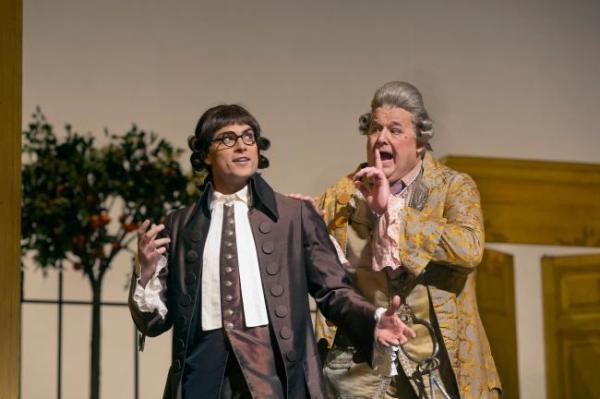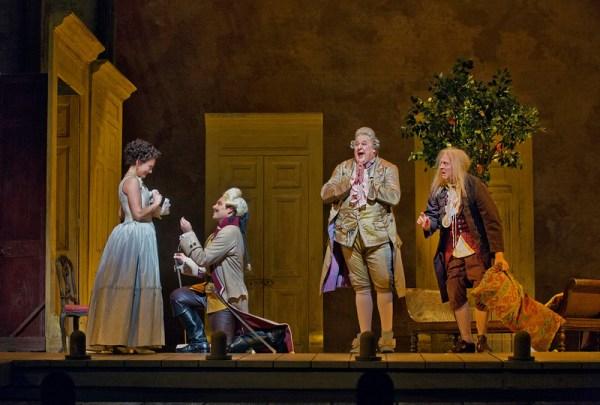Listening to opera on the radio is a completely different experience from seeing it on the stage. I first noticed this dichotomy when, after years of hearing the regular Saturday afternoon Metropolitan Opera broadcasts on the air, I finally witnessed a live presentation of Lucia di Lammermoor at the New York State Theater. It was the most thrilling and life-altering experience of my early theater-going career, I have to tell you. To hear those fresh young voices rise above the orchestra pit, as Donizetti’s music cut straight to the bone (and to my stomach), was a cherished moment I will never forget.
Later, when videos, DVDs and Blu-ray Discs™ became far more accessible for opera fans to enjoy I realized there was another aspect to a live performance: with the addition of subtitles and supertitles, one could more fully understand what all the posing and strutting were about. Up to that time, I had spent a small fortune amassing an enviable collection of tapes and LPs geared toward recapturing that initial excitement of live theater in the flesh. Now, I could wallow in this newfound treasure trove of works with renewed enthusiasm and a much clearer idea of the difficulties of producing opera.
I find it funny, then, as well as somewhat ironic, that after so many decades of theater-going and record/video collecting I’m back to where I started, every time I hunker down in front of the stereo to tune in to the next in the continuing series of Saturday broadcasts. On the other hand, my ears have grown accustomed to hearing opera on this vastly reduced scale, which helps bring this “unseen” dimension into sharper focus as I assess the caliber of each week’s performance.
This is why reviewing the Metropolitan Opera’s 2012-2013 radio season requires a bit of tempering on my part, with the knowledge that I lack the all-important visual element, eventually filled in of course with Public Television’s delayed High Definition broadcasts. For now, readers should take note of the above caveat as I make do with the essentially auditory portions of our program.
A Barber for the Masses

Alek Shrader & John Del Carlo (minnesota.publicradio.org)
This brings me to my latest review of Gioachino Rossini’s The Barber of Seville. An English-language adaptation of the Pesaro-born composer’s delightful 18th-century masterwork, it was broadcast on December 22, in director Bartlett Sher’s crowd-pleasing production. The problem here wasn’t so much the non-colloquial Italian as it was unintelligible English.
The new translation by poet and literary critic J.D. McClatchy, whose ground-breaking Seven Mozart Librettos: A Verse Translation should be in every opera lover’s library – while solid and workmanlike in print – was unworkable in execution. An admirable substitution for Cesare Sterbini’s imaginative Italian one (an acrobatic verbal exercise, if truth be told) this new version was, in a word, a letdown. It just wasn’t funny enough, at least to my mind, which led to my biggest deception with the entire enterprise, and that is, its inability to be understood.
One could overlook this basic point if the opera had been performed to perfection (a rare commodity indeed, even in the best of times), but the worst that could be said for McClatchy’s adaptation was that it was frustratingly inappropriate for its target audience: young children and their parents.
This being a children’s matinee performance, the other major complaint, from my part, was the cutting of more than an hour’s worth of music from this superb score. The end result wasn’t anywhere near what Rossini envisioned. Indeed, this was not The Barber of Seville as we’ve come to know it, but “half scenes” and “bits and pieces” of episodes and arias from one of the standard repertoire’s most astutely-crafted creations.
One might as well call this The Cut-Rate Barber of the Met, for all the good the translation did to untangle the opera’s complicated plot. I should’ve known something was up the minute the world famous overture sounded. Hah, did I say overture? Not even close! What was left of this world famous piece was chopped up and spit out in record time. Things went from bad to worse when the titular barber entered the picture. It’s a shame, really, to have heard Figaro’s tuneful showstopper, “Largo al factotum,” sliced up and shorn of nearly half its delectable vocal patter, while the same character’s effervescent duet with Count Almaviva whizzed by in no time: there was no setup, no substance, just words… and words on top of words. Ugh, a stylistic nightmare!

Isabel Leonard, Shrader, Del Carlo & Rob Besserer (stageandcinema.com)
Among the vocalists, only John Del Carlo’s crotchety old Doctor Bartolo reached the histrionic heights. As far as I could tell, his explosive bass-baritone was the most consistent of the mini-portrayals. The other artists – especially the buoyant Moscow-born Figaro of Rodion Pogossov, the featherweight Almaviva of Alek Shrader, and the technically proficient Rosina of New Yorker Isabel Leonard – performed over and above the call of duty, although none of them were particularly adept with the new translation, with Shrader’s uncomfortable-sounding Count leading the way.
In this climate, where every note counted, bass Jordan Bisch’s Don Basilio was reduced to a cipher after his wonderfully campy “La calunnia” was expunged from the overall concept. What was the sense of that? It defeats the entire purpose of the plot to cut this aria out, and leaves innocent audience members in the dark just as they’ve settled back in their seats. I imagine most youngsters would have been startled at this implausible fellow, wondering why Basilio was making such a belated entrance in Act II. “Buona sera, mio signore” is a comedic tour de force, bar none; but instead of Rossini’s carefully constructed build-up to this hilarious scene what we heard was more in line with The Sound of Music’s “Goodbye, farewell, Aufwiedersehen, good night.” And that’s all, folks! In fact, all the arias and ensembles suffered from the same cosmetic surgery: too short, too quick, with not enough development.
A Teaching Moment
Teaching young children about the performing arts is a noble and well-intentioned cause. I should know: as the product of a public-school education, I can firmly attest to the fact that the thought-process behind these maneuvers was to expose as many youngsters as possible to the wonders of music, art and theater.
To the best of my recollection, the works I saw as a child were note complete, or as complete as they were allowed to be given the time restrictions placed on our school’s schedule. Still, dumbing opera down for modern-day audiences and their offspring is not the best way to do it. Okay, children can turn fidgety to the point of irritation, as boredom quickly sets in. Yet they’re smarter and infinitely more perceptive than adults often take them to be. So let’s give our little people a chance, shall we, by playing these exceptional pieces as they were intended – without hacking the very life out of them, if you please!
In Julie Taymor’s production of The Magic Flute for kids, the self-same Professor McClatchy kept the richness and substance of Mozart’s score virtually intact. In that “other” English-language adaptation what was trimmed away were the lengthy dialog passages, which are generally cut back anyway, even in the original German. But by trimming The Barber of Seville down to Pee Wee Herman’s size, we’re giving Figaro his own haircut – even at discount prices, this is too close of a shave for comfort. If I were the parent of a school-age kid, I’d demand my money back (or half of it, at any rate).
My only hope is that this purported Barber was given with clearly legible supertitles – the better to discern the non-discernible plot, my dear. As for the rest of the radio audience, we’re hopelessly lost in translation. A grade of C- is in order. Ω
Copyright © 2012 by Josmar F. Lopes

